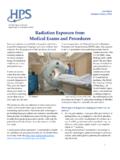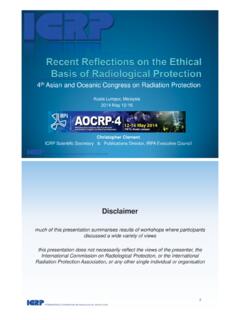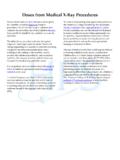Transcription of Tritium Fact Sheet - Health Physics Society
1 1 Health Physics Society Specialists in Radiation Safety Tritium Fact Sheet Adopted: March 2011 General Information Tritium is the only radioactive* isotope of hydrogen and it is commonly represented by the chemical symbol H-3 or 3H. While the most common form of the hydrogen atom has a nucleus consisting of a single proton, Tritium s nucleus is comprised of three particles: two neutrons and a single proton. This configuration makes Tritium s nucleus unstable and tending to undergo a process of radioactive transformation. During this decay process, the Tritium atom transforms into a nonradioactive he-lium atom and, in the process, emits a form of ionizing radiation known as a beta particle. The emission of this beta particle during the decay process is what makes Tritium a potentially hazardous material.
2 The half-life of Tritium is years. The beta particle that is emitted by Tritium is considered to be very weak, hav-ing an average kinetic energy of 6 keV. As a result, these particular beta particles can only travel about 6 mm in air before they lose their ability to cause ionizations. In tissue, Tritium s beta particle is so weak that it cannot penetrate the typical thickness of the dead layer of skin that exists on the outside of the human body. For this reason, the beta particle emitted by Tritium is generally only considered to be hazardous if a significant quantity of Tritium is, or has the potential to be, taken into the body. The chemical behavior of Tritium is essentially the same as that of hydrogen. This means that Tritium , just like stable hydrogen, can exist in a gaseous state or, more commonly, in the form of water.
3 In fact, Tritium atoms have a tendency to replace one of the stable hydrogen atoms in water, H20, thus becoming a part of the water molecule. The resulting compound is known as tritiated water, with the chemical formula HTO or T2O. Tritiated water is colorless and odor-less, just like regular water, and can exist alongside regular water molecules. Given the chemical properties of Tritium and the fact that roughly two-thirds of human body mass is composed of water, it is very common for Tritium to exist within the hu-man body. Sources Tritium can be produced in several ways and is gener-ated naturally in the atmosphere through interactions between nitrogen in the air and radiations originating from outer space, known as cosmic rays. Tritium is also produced by nuclear reactions that are brought about through man-made processes.
4 These are generally lim-ited to nuclear reactions that occur within a nuclear re-actor, during the detonation of a nuclear weapon or, to a much lesser extent, in particle accelerators. All of these processes produce Tritium because they create situations where nuclear reactions, such as fission, fusion, and acti-vation, can occur. nuclear weapons, particularly thermonuclear weapons, have the ability to produce large quantities of Tritium . There was a time when the atmospheric testing of nu-clear weapons contributed significantly to the amount of Tritium present in the environment; however, since the signing of the Partial Test Ban Treaty in 1963, the major nuclear -armed countries have limited their testing activi-ties to underground nuclear detonations. Consequently, the amount of Tritium in the environment has been de-creasing since 1963.
5 While Tritium is still produced dur-ing subterranean tests, they are designed to contain the majority of the Tritium underground at the test site, pre-venting releases into the greater environment. *Words in italics are defined in the Glossary on page 5. 2 nuclear reactors produce Tritium as a direct product of nuclear fission as well as through activation of other ma-terials that are in close proximity to the fission process. These materials are generally limited to those that are found inside a nuclear reactor core and can include con-trols rods and cooling water. While most of the Tritium that is generated inside a reactor remains there, some of that Tritium can be transported, usually via the cooling water, which is continuously circulated through the re-actor core during operation. Commercial nuclear power plants produce Tritium as a byproduct of generating electricity, while other nuclear reactors, known as pro-duction reactors, are specifically designed to produce radioactive isotopes, including Tritium .
6 Such reactors are generally limited to government facilities involved in the production and maintenance of nuclear weapons. However, a commercial power reactor was recently au-thorized to undertake Tritium production activities. To a lesser extent, small research and test reactors may also produce low concentrations of Tritium . Tritium can also be released into the environment from facilities that handle the material but do not necessarily produce it. In the United States, these would primarily be Department of Energy (DOE) facilities involved in work related to the nuclear weap-ons arsenal or limited noncommer-cial fuel-reprocessing operations. Tritium in the Environment Tritium exists throughout the worldwide environment due to both natural and man-made proc-esses. Although Tritium is con-stantly undergoing radioactive de-cay, which reduces the amount of Tritium in the environment, it is also being generated by the proc-esses discussed above.
7 These com-peting processes of production and decay result in a dynamic world-wide inventory of Tritium , which has fluctuated over time and can be correlated with hu-man activities, most notably the atmospheric testing of nuclear weapons. Tritium is found throughout the global environment: in the atmosphere, ground water, soil, rivers, lakes, streams, and oceans. Over time Tritium that is released into the environment becomes distributed by the same processes that transport water, most notably the hydro-logical cycle, otherwise known as the water cycle. This process tends to dilute Tritium releases by spreading them out, largely preventing any concentration in the environment. However, the distribution and dilution of Tritium is not instantaneous and, therefore, individuals in close proximity to Tritium releases are generally ex-pected to be exposed to a greater extent than others who are farther away.
8 For this reason, regulations have been designed to limit the exposure to members of the public who have potential for exposure. In practice this means that organizations that release Tritium , such a nuclear power plants, are required to ensure that their releases will not cause any single individual member of the pub-lic to receive an exposure above the prescribed public dose limit. Applications In addition to being produced by nuclear detonations, Tritium is also a critical component in modern nuclear weapons, and an inventory of Tritium is maintained for this purpose. Tritium is also a prospective fuel in the effort to develop commercially viable nuclear fusion re-actors. In the life sciences, Tritium is often bound to organic com-pounds and used as a radioactive tracer to study the metabolism of that compound in a biological sys-tem, such as an organism or cell.
9 Tritium is also found in a range of common consumer items because it can be used in combination with phosphors in order to make materi-als that are self-luminous (glow in the dark), meaning that these items will produce light without any sup-plemental power supply. These items include gun sights, watch dials, key chains, and Tritium exit signs. It has been estimated that there are greater than 2 million self-luminous Tritium exit signs in use in the United States. It is important to understand that Tritium itself does not produce visible light or glow in the dark and that the Tritium in these devices only serves to ener-gize the light-producing phosphors in these items. Photo courtesy of ANS nuclear Cafe Tritium Exit Sign 3 While the use of Tritium in self-luminous devices is common and not considered to pose any serious threats to safety, Health , or security, the devices do have the potential to release Tritium to the environment if dam-aged.
10 If this happens, low levels of Tritium exposure to nearby individuals and a potentially expensive cleanup effort can result. This is only known to happen if the Tritium -containing device has been physically damaged. Additionally, devices such as Tritium exit signs are pro-hibited from disposal as regular solid waste. Instead, they should be disposed of in accordance with applica-ble federal and state regulations , which typically in-volve the return of the Tritium exit signs to the manufac-turer, the distributor, or a licensed radioactive waste broker. Failure to dispose of these items properly can result in regulatory penalties from federal and/or state agencies. Biological and Health Effects Tritium can potentially be hazardous to human Health because it emits ionizing radiation, exposure to which may increase the probability that a person will develop cancer during his or her lifetime.









